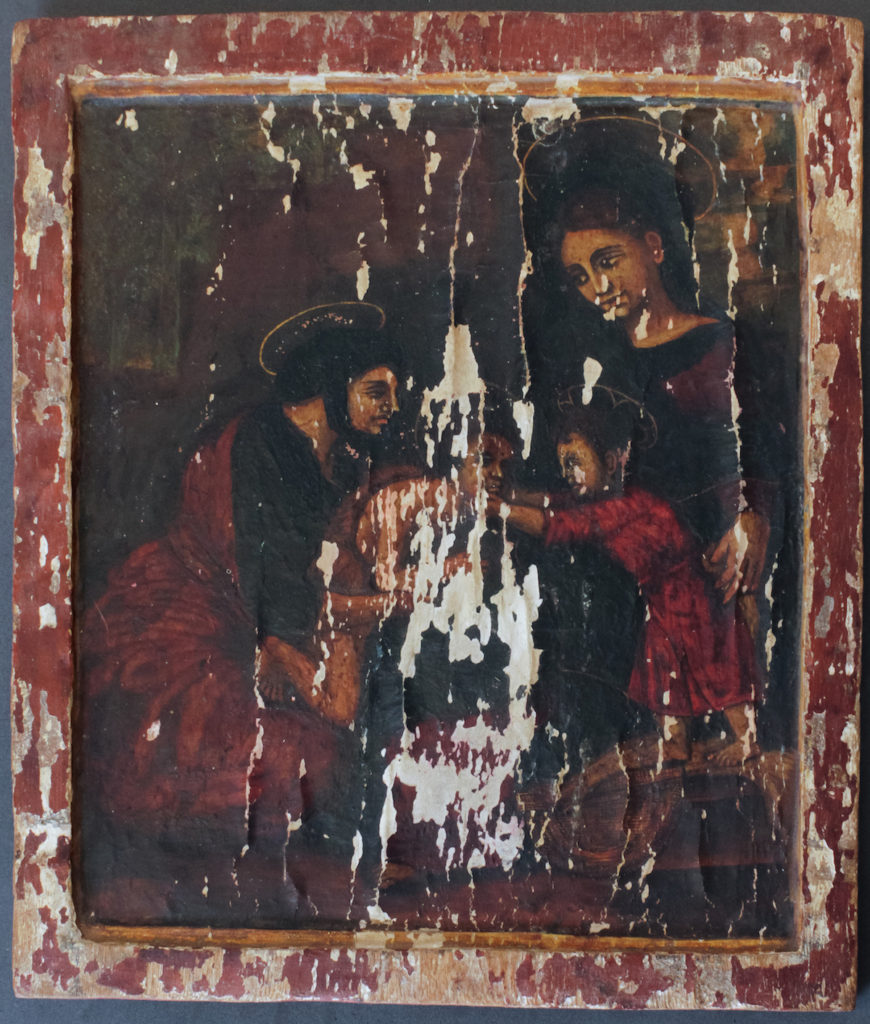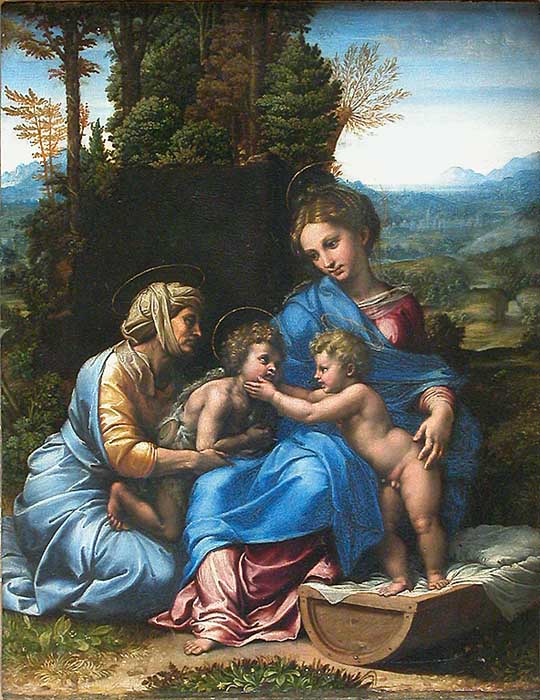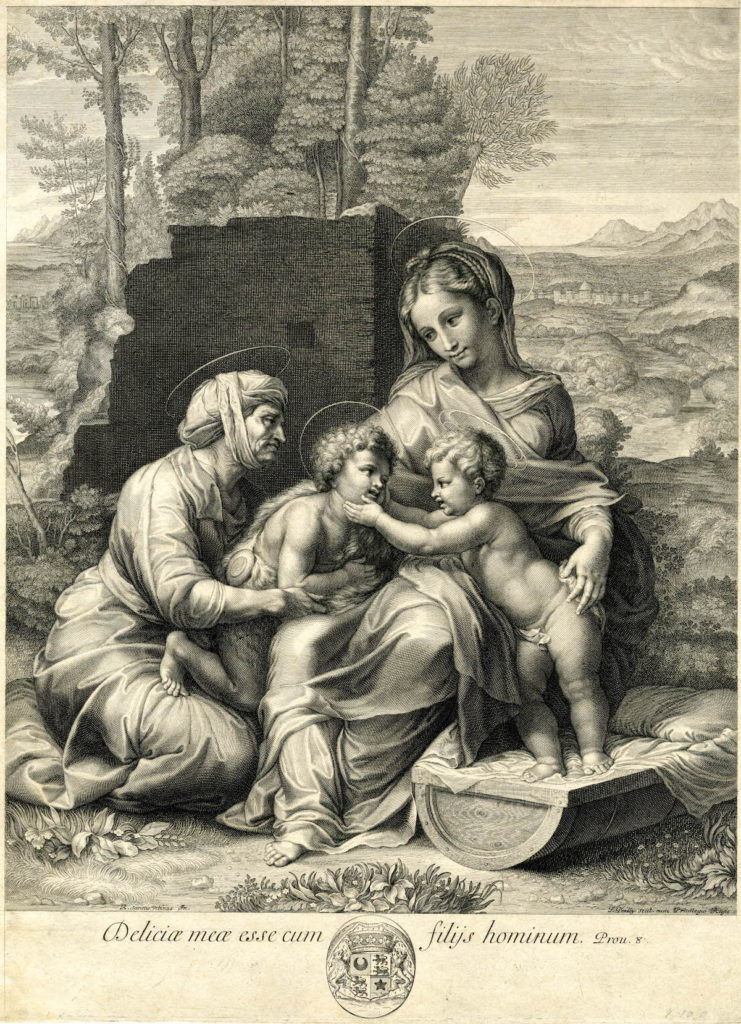
Fig. 1. Unidentified Ethiopian artist, The Little Holy Family (ቅዱስ ቤተሰብ), c. 18th century. Unknown paint on wood panel, 36.5 x 32 x 1.5 cm. Musée du Quai Branly-Jacques Chirac, 71.1931.3600. Photograph by the author, 2015.
Darkened by aged varnish, with cracked paint peeling off like the bark of a plane tree, the small wooden panel stands out amongst the boldly-toned Ethiopian Orthodox paintings in Paris’ Musée du Quai Branly-Jacques Chirac (Fig. 1). Its softly shaded faces and unusually draped textiles suggest the court art of turn-of-the-eighteenth-century Gondär—the capital of the Christian Ethiopian empire—yet its composition and smoky perspectival background are without clear Ethiopian parallels. Teetering on a wooden crib, the haloed infant Christ reaches across his mother’s thigh to caress the face of a young John the Baptist. Clad in a hair shirt, John is held by St. Elizabeth, whose head wrapper is so dark that its chinstrap resembles a thick beard. Previous scholars have tentatively attributed this enigmatic painting to an unknown European artist working in sixteenth-century Ethiopia.[1] However, my research indicates that it is an unidentified Ethiopian artist’s eighteenth-century adaptation of The Little Holy Family, an oil painting from circa 1518 attributed to Giulio Romano (c. 1499-1546), a member of the school of Raphael (Fig. 2).[2]

Fig. 2. Workshop of Raphael, attributed to Giulio Romano, The Virgin with Child, Saint Elizabeth, and the Child Saint John the Baptist in a Landscape, called “The Little Holy Family,” c. 1518. Wood, 38 x 32 cm. Musée du Louvre, Inv. 605 © Musée du Louvre/A. Dequier – M. Bard.
While European art and artists had contributed to Ethiopia’s courtly religious art since the 1400s, a disastrous Jesuit mission (1557-1632) prompted a civil war and the subsequent destruction of all things European. Despite this, some European art remained secreted away. Prints and illustrated books were among the most important foreign sources at Gondär’s scriptoria and workshops, where these illicit yet visually tantalizing images were incorporated into what became known as the “Gondärine style” of painting.[3] Given that little European art entered Ethiopia following the Jesuit mission, this adaptation of Romano’s painting is exceptional.
Romano’s work likely came to Ethiopia in print form, a medium used earlier by the Jesuits to popularize images like the Virgin of Santa Maria Maggiore.[4] The slender haloes above each holy figure in the painting suggest that the unknown Ethiopian artist adapted the French engraver François de Poilly’s widely reproduced 1648-81 engraving of Romano’s painting (Fig. 3).[5] Though post-dating the failed Jesuit mission, it may have been brought to Ethiopia by another Jesuit, Charles François-Xavier de Brèvedent S.J. (1659-99), who traveled incognito to the court of Emperor Iyasu I (r. 1682-1706) as “Yusuf,” the Arabic-speaking servant of doctor Charles Poncet (1655-1706).[6] Secretly charged with returning Ethiopia to Catholicism, Poncet and de Brèvedent were outfitted with gifts for Ethiopia’s sovereign by Consul Benoît de Maillet.[7] As these men and their royal sponsor, King Louis XIV, were French, it would not be unusual for de Poilly’s print to be among these presents. Equally, de Poilly had worked for the Jesuits, who tended to disseminate art made by Society affiliates.[8] As doctor-in-residence, Poncet stayed at the royal compound in Gondär until 1700, presenting an array of fine goods to Iyasu, including images of the saints.[9] The engraving of The Little Holy Family may have been among these or Poncet’s other, unspecified presents, or among those carried by de Brèvedent.[10]

Fig. 3. François de Poilly, The Little Holy Family, 1648-1681. Engraving, 40.7 x 30.1 cm. The British Museum, 1917,1208.1533. CC BY-NC-SA 4.0 © The Trustees of the British Museum.
Like all European models, de Poilly’s print was modified to appeal to Ethiopian aesthetics. Cropped to fit the typical panel painting format, the composition and figures—particularly the folds of their clothing and the darkening of their hair—were transformed according to the style used at the Gondärine court. Though nude in the European prototypes, the Christ child wears a deep red short-sleeved robe; indeed, all of the necklines and sleeves in the Ethiopian painting have been altered for modesty. This pictorial censorship—or at least, a preference for the clothed form—followed earlier Ethiopian adaptations of European prints, which rejected fleshier bodies and dynamic compositions in favor of stoic, veiled forms.
Stylistically, the painting appears to have been created in the early eighteenth-century transition between the two Gondärine styles. Though the ribbon-like quality of the folds in Elizabeth’s robe evoke the looping textiles of the First Gondärine Style, the high level of illusionism and the naturalistic shading on the faces were features perfected by many Second Style Gondärine painters. While the Second Style is more naturalistic compared to the First Style, it is still more schematic and partial to rounded volumes and planar facial features than its European counterparts. Details of such elements have been altered from the print: noses were straightened into long slopes, curved eyebrows shaped into sharp horizontal lines (St. Elizabeth), and eyelids and lashes modified into sharply tapered strokes of black paint. Wrinkles of age or expression were smoothed (St. Elizabeth and Mary), while the rounded, plump limbs of the children in the European model were simplified into tubular forms.[11] Alongside its affinity with the European print—which suggests a circa 1699 introduction of the composition to Ethiopia—the stylistic assessment of this painting as a product of eighteenth-century Gondär is reinforced by the fact that the Dakar-Djibouti Expedition collected it there in 1932.
Ultimately, The Little Holy Family is an anomaly in Ethiopian Orthodox art, known only by the single panel now in Paris. Given the political climate of turn-of-the-eighteenth century Ethiopia, the work was likely a royal commission. Flouting the de facto ban on Europeans and their art, Emperor Iyasu I—a known art-lover—may have embraced de Poilly’s print as an emblem of Christianity. Although the image was brought into his kingdom by the hands of those who wished to convert its inhabitants, its visual power and religious meaning ultimately overpowered its suspect origins. The singularity of the painting also suggests that its model was quickly rejected for some as-of-yet-unknown reason, perhaps its lack of conformity to Orthodox visual norms. As Ethiopian artists drew inspiration for manuscripts and wall paintings from other early modern illustrated European sources (including the Evangelium Arabicum, the Evangelicae historiae imagines, and the Virgin of Santa Maria Maggiore) during this same era, the failed experiment of The Little Holy Family demonstrates that foreign models were not automatically accepted into the Orthodox visual canon, but were instead incorporated selectively.
Kristen Windmuller-Luna, PhD, is a curator and historian of African arts based in New York City
[1] Formerly in the collection of Paris’s Musée de l’Homme, the painting’s style and iconography led it to be identified as a “Presentation of St. John the Baptist.” See Claire Bosc-Tiessé and Anaïs Wion, Peintures sacrées d’Ethiopie: collection de la Mission Dakar-Djibouti (Saint-Maur-des-Fossés: Sépia, 2005), 62.
[2] Romano’s painting in turn draws from the Holy Family of Francis I and the Holy Family called “La Perla” of his mentor Raphael, the similarities in physiognomy leading past scholars to attribute the work to the master himself or his workshop. Frederick Hartt, Giulio Romano (New Haven: Yale University Press, 1958), 26, 53. A 1518-19 drawing from the Romano-attributed painting remains attributed to Raphael’s school (Royal Collection Trust, RCIN 912740).
[3] Named after the court city of Gondär, founded in 1636 or 1637, “Gondärine style” is an ahistorical nomenclature created by twentieth-century art historians to classify a style that in fact originated during the early seventeenth century. The illuminated manuscript and painting traditions blossomed in the courtly scriptoria of Gondär and its nearby churches, moving through what has been classified as a First Gondärine Style (c. 1620-1682) and a Second Gondärine Style, which first blossomed during the reign of Iyasu I (r. 1682-1706). Both styles are generally characterized by the use of three-quarter pose, vivid pigments, the inclusion of both secular and religious objects, and the detailed rendering of textiles. The Second Style tends towards rounder forms and naturalistic, gradient shading, while the First Style uses “mask-like” shading.
[4] Indeed, the Italian engraver Giovanni Jacopo Caraglio (ca. 1500/1505-1565) executed a print of The Holy Family in the sixteenth century, though it lacks the haloes seen in the Ethiopian painting.
[5] See British Museum 1855,0609.96, V,4.12, and V,5.11, V,5.13 for additional states and reworkings of this print.
[6] Antonio Maria Nacchi S.J. to Giovanni Maria Baldigiani S.J., March 19, 1698, in Camillo Beccari, Rerum Aethiopicarum Scriptores Occidentales Inediti a Saeculo XVI Ad XIX, Vol XIV, Relationes et Epistolae Variorum, vol. 14 of 15 (Rome: 1903), 20.
[7] Benoît de Maillet to Pontchartrain, May 12, 1698 in Beccari, Rerum Aethiopicarum Scriptores Occidentales, 31-32. While Poncet was ostensibly on a medical mission to cure Emperor Iyasu of a skin disease, he and de Brèvedent were informal agents of the French crown, sent to Ethiopia in part to facilitate commercial relations between France and Ethiopia and the restoration of the Jesuit mission. Theodore Natsoulas, “Charles Poncet’s Travels to Ethiopia, 1698-1703,” in Glenn J. Ames and Ronald S. Love, eds., Distant Lands and Diverse Cultures: The French Experience in Asia, 1600-1700 (Westport and London: Praeger, 2003), 73.
[8] His works for the Society include a frontispiece for Jean Dubreuil’s 1649 Troisième et dernière Partie de la Perspective pratique… José Lothe, L’oeuvre gravé de François et Nicolas de Poilly d’Abbeville, graveurs parisiens du XVIIe siècle (Paris: Paris-musées – Commission des travaux historiques de la Ville de Paris, 1994), 60.
[9] These gifts included paintings, a range of fine works in glass, a crucifix, and miniature images of the saints. “…je lui fis mes presens, qui consistoient en peintures, en miroirs, en cristaux, & en d’autres ouvrages de verre fort bien travaillés.” Charles Poncet in Lettres édifiantes et curieuses écrites des missions étrangères par quelques missionnaires de la Compagnie de Jesus. IV. recueil (Paris: Nicolas Le Clerc, 1704), 315. “L’Empereur ne laissa pas d’accepter le Crucifix en relief que j’eus l’honneur de lui présenter avec quelques mignatures. Il les baisa avec respect, & les fit mettre dans son cabinet. Les mignatures estoient des images des Saints, dont il fit écrire le nom au base en Ethiopien.” Poncet in Lettres édifiantes et curieuses, 372.
[10] Though the Jesuit de Brèvedent died of “the flux” (dysentery) just one day’s journey from Gondär in July 1699, his copy of Wierix’s illustrated Synopsis of the Life and Passion of Our Savior Jesus Christ reportedly reached Iyasu I’s court painters. Deborah E. Horowitz et al, Ethiopian Art: the Walters Art Museum (Lingfield: Third Millennium, 2001), 64; Richard Leslie Hill, A Biographical Dictionary of the Sudan (London: Cass, 1967), 86.
[11] One such comparative Second Style work, produced in the Gondärine workshops during the reign of Iyasu II (r. 1730-55), is the 1740-1755 triptych painted by the Masters of the Diaphanous Gown (Addis Ababa University, Museum of the Institute of Ethiopian Studies, IESMus3524). It has a central image of the nursing Virgin with sharply outlined eyes, planar noses that extend downward in a single swoop from the eyebrows, and smooth limbs such as those seen in the Holy Family. Both paintings share a palette of muted reds, greens, and diffuse brown shadows.
Cite this note as: Kristen Windmuller-Luna, “Giulio Romano’s The Little Holy Family in Africa: Identifying an 18th-Century Ethiopian Painting”, Journal18 (December 2016), https://www.journal18.org/1210
Licence: CC BY-NC
Journal18 is published under a Creative Commons CC BY-NC International 4.0 license. Use of any content published in Journal18 must be for non-commercial purposes and appropriate credit must be given to the author of the content. Details for appropriate citation appear above.
